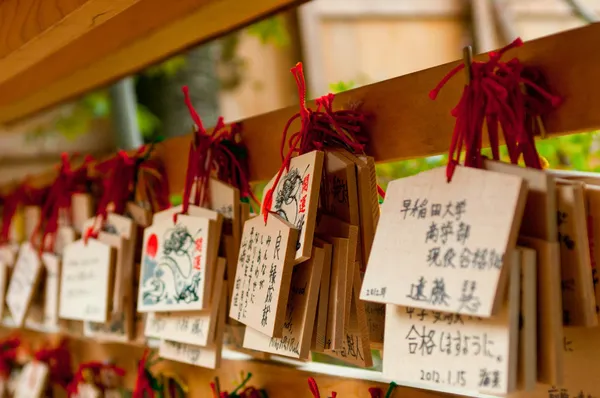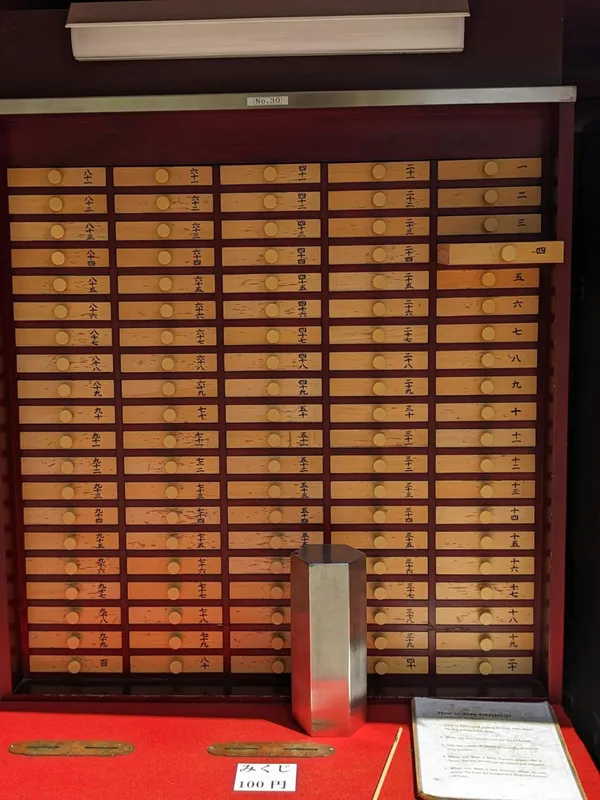60. OMIKUJI & EMA
Omikuji (おみくじ), traditional fortune slips & Ema (絵馬), votive tablets on which visitors write their wishes and prayers.
EMA
If you've ever visited a Shinto shrine or a Buddhist temple in Japan, you may have noticed small wooden plaques hanging from racks or wooden frames. These are ema (絵馬), votive tablets on which visitors write their wishes and prayers. But where do they come from, how do you use them, and where can you find them in Japan?
What is an ema?
Ema are wooden plaques sold at Shinto shrines and Buddhist temples. The word ema (絵馬) literally means “picture of a horse” (絵 - e = picture, 馬 - ma = horse). In ancient times, people would offer real horses to deities as a way to seek divine favor or express gratitude. Over time, this tradition evolved into the use of wooden tablets decorated with various illustrations.
Visitors write their prayers, wishes, or goals on these plaques and hang them on designated racks, hoping that the deities (kami in Shinto or Buddhist figures) will grant their requests.
What can you write on an ema?
People use ema to make wishes related to different aspects of life, such as:
Success in exams and studies
Prosperity and career advancement
Love and relationships
Health and family protection
Safe travels
Personal dreams and spiritual aspirations
There are no strict rules on how to write a wish. Some people keep it simple, like "I hope to pass my exams," while others write more detailed requests. It is common to include your name and sometimes the date to mark your visit.
How to use an ema?
Purchase an ema – Available at shrines and temples, they typically cost between 500 and 1,000 yen.
Write your wish – Use the provided pens or markers to write your prayer on the back of the plaque.
Hang the ema – Attach it to the designated rack at the shrine or temple. It is believed that the deities will read your wish.
Pray or express gratitude – Some people take a moment to pray or bow after hanging their ema.
Ema designs and their meanings
Ema come in many different designs, depending on the shrine or temple. Some common motifs include:
Zodiac animals – Related to astrology and Buddhist traditions.
Shinto deities and symbols – Such as torii gates or representations of kami.
Hearts and couples – Common at shrines focused on love and marriage.
Dragons, foxes, cranes… – Sacred animals symbolizing strength, wisdom, or longevity.
Where to find ema in Japan?
Ema are available at most shrines and temples, but some locations are especially famous for their votive plaques:
Meiji Shrine (Tokyo) – A popular place for prayers for prosperity and happiness.
Yushima Tenmangu (Tokyo) – Famous among students seeking academic success.
Fushimi Inari Taisha (Kyoto) – Known for its thousands of torii gates and ema shaped like foxes (kitsune).
Kiyomizu-dera (Kyoto) – A temple offering ema focused on love and general good fortune.
Osaka Tenmangu (Osaka) – A shrine frequented by students and professionals wishing for success in exams and careers.
Ema are more than just souvenirs; they are a way to engage with Japan’s spiritual traditions and take part in a centuries-old practice. Whether you're seeking success, love, or protection, writing a wish on an ema and hanging it at a shrine is a meaningful experience that connects you to Japan’s rich cultural heritage.

OMIKUJI
If you've ever visited a Japanese shrine or temple, you may have seen small slips of paper tied to tree branches or special racks. These are omikuji (おみくじ), traditional fortune slips that offer guidance and predictions for different aspects of life. But what exactly are they, and how do you use them?
What is omikuji?
Omikuji are fortune-telling slips found at Shinto shrines and Buddhist temples across Japan. The word "omikuji" (おみくじ) is written with the kanji 御神籤, which roughly translates to "sacred lottery." These slips contain predictions about different areas of life, such as:
Overall fortune (運勢 - unsei)
Love and relationships
Health
Career and business
Travel
Academics and studies
Each slip has a general fortune ranking, ranging from excellent luck to terrible misfortune.
Omikuji fortune rankings
While wording may vary, omikuji generally have the following rankings:
大吉 (Daikichi) – Great blessing / Excellent luck
中吉 (Chūkichi) – Middle blessing / Good luck
小吉 (Shōkichi) – Small blessing / Moderate luck
吉 (Kichi) – Blessing / Luck
半吉 (Hankichi) – Half blessing / Partial luck
末吉 (Suekichi) – Future blessing / Uncertain luck
凶 (Kyō) – Curse / Bad luck
大凶 (Daikyō) – Great curse / Very bad luck
While daikichi is the best fortune, drawing kyō or daikyō is considered bad luck. However, in Japanese culture, misfortune can be seen as a chance to reflect and improve.
How to draw an omikuji
Visit a shrine or temple – Omikuji are available at most major Shinto shrines and Buddhist temples in Japan.
Make a small offering – Typically, you pay 100 to 300 yen at an omikuji box. Some locations use vending machines, while others have wooden drawers.
Draw a slip – Shake a wooden box containing numbered sticks and pull one out. The number corresponds to a drawer where you take your fortune slip.
Read your fortune – The omikuji will have a general fortune ranking and details about different aspects of life.
Tie or keep your omikuji – If you receive bad luck, it’s customary to tie the slip to a designated area at the shrine or temple to leave the misfortune behind. If you get good luck, you can either keep it in your wallet or tie it as well, depending on personal belief.
Where to try omikuji in Japan
Omikuji can be found at almost any shrine or temple, but some famous places include:
Senso-ji (Tokyo) – One of the most visited temples in Japan, known for its high number of "bad luck" omikuji.
Meiji Shrine (Tokyo) – A peaceful location where you can draw a unique omikuji with poetic messages instead of traditional rankings.
Fushimi Inari Taisha (Kyoto) – A popular Shinto shrine famous for its thousands of red torii gates.
Kiyomizu-dera (Kyoto) – A historic temple offering both traditional and love-related omikuji.
Osaka Tenmangu Shrine (Osaka) – Known for students seeking academic success, with omikuji focused on studies.
Omikuji are an exciting way to experience Japanese spiritual traditions while visiting shrines and temples. Whether you get great luck or bad luck, these fortune slips remind us that life is full of changes and opportunities for growth. So next time you visit Japan, try drawing an omikuji and see what the future holds!

Á procura de coisas para fazer?
Confira meu guia para as melhores coisas gratuitas para fazer, bem como itinerários e dicas de viagem para tornar sua viagem inesquecível.

